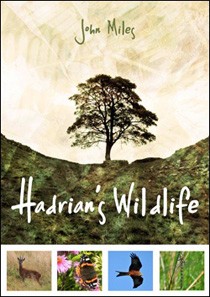Hadrian's Wildlife by John Miles

Thanks to outdoor pastimes such as walking, cycling or birding, many are drawn back in subsequent years and relish the opportunity to explore this former frontier further. John Miles has gone several steps beyond this; not only does he live and work around the Wall, but does so in a role with the RSPB that influences the landscape and the nature it supports. Now, in his sixth book, he pens a companion guide to the wildlife of Hadrian's Wall.
Hadrian's Wildlife is a splendid blend of Wall history (both ancient and modern) intertwined with the natural history of the landscape it cuts across, acting as a guide to the birds and wildlife that can be found around the remnants of this once imposing border.
To call this simply a guidebook would be a disservice to the varied subject matter covered. Hadrian's Wall was once a place where cultures clashed, and people fought over land and the resources it provided. John, with his history as an employee of the RSPB, has been able to call on the recent struggles between conservation and other interests. Kielder, Geltsdale and Langholm are some of the key conservation battlegrounds of the last three decades; each is revisited with many of their tales recounted from someone who was there, in the thick of the action.
Not everyone will agree with the interpretation of some events, and some will no doubt dismiss much of what is written about the persecution of raptors in the area as speculative. However, there is no tabloid sensationalism here, just the repetitive themes of loss in the face of vested interests, and often ignorance. The author must have despaired at some of the events that took place at times.
From Red Kite reintroductions in the Derwent Valley to a skua-filled seawatch on the Solway via the tranquil Northumbrian loughs, this book will transform a visit to Hadrian's Wall country for anyone with even a passing interest in natural history. John's passion for birds is evident and his local knowledge oozes from the text, but I was pleasantly surprised with the detail on a range of other wildlife and plants — ranging from mammals to dragonflies and crayfish to cranberries via calaminarian grassland.
The superb field-sketches from Northumbrian birder and artist Mike Henry are a real bonus and complement the flavour of the text well. My only niggle was that the quality of one or two of the photographic images wasn't as good as I would expect for a book with a £16.99 price tag.
Whether you're walking, biking or birding along the Wall, this guide will enhance the experience and provide a unique view on the wildlife and its place in the past, present and future of this World Heritage Site.
Softcover, 150 pages, 16 plates with colour photos, b/w photos and b/w illustrations.
Whittles Publishing 2012, ISBN 978-1-84995-063-3, RRP: £16.99


